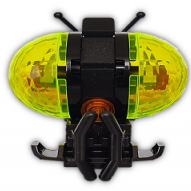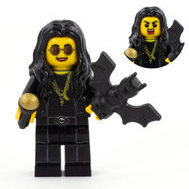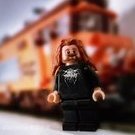Search the Community
Showing results for tags 'electric'.
Found 49 results
-
29.09.2023 - new locomotives Hello there and thank you for stopping by! Since posting last time i mocced up 3 more locomotives. They have been kept in the same "9V era plus style" i usually build in. The first new addition is a EMD GP "High Nose" Locomotive. It is based loosely on GP7 and GP9 Locomotives and is build in a CN Paint scheme to not look out of place when it runs together with the 10133 BNSF Loco. Speaking of 10133, the lower part and the longer hood-roof is heavily based on this set. EMD GP Highnose CN by Henrik S, auf Flickr EMD GP Highnose CN by Henrik S, auf Flickr EMD GP Highnose CN by Henrik S, auf Flickr EMD GP Highnose CN by Henrik S, auf Flickr Next we have a EMD Switcher Locomotive. Again, it resembles no particular prototype, it is basically an attempt to capture the general vibe of this type of locomotive in a 6 wide format. EMD SW Switcher Locomotive by Henrik S, auf Flickr EMD SW Switcher Locomotive by Henrik S, auf Flickr EMD SW Switcher Locomotive by Henrik S, auf Flickr EMD SW Switcher Locomotive by Henrik S, auf Flickr EMD SW Switcher Locomotive by Henrik S, auf Flickr The 3rd Locomotive is a european one, it is loosely based on the swiss Bernina Crocodile. Most of the parts used to build this locomotive come from set 10277 ( which was killed to create this 6 wide, 9V powered baby crocodile ). Bernina Krokodil (10277 Alternative) by Henrik S, auf Flickr Bernina Krokodil (10277 Alternative) by Henrik S, auf Flickr Bernina Krokodil (10277 Alternative) by Henrik S, auf Flickr Hope you enjoy, comments and constructive criticism are always welcome! _____________________________________________________________________________________________________________________________________________________________________________________________________________________________ It´s been a long time since i last posted in this thread . Some pictures on flickr were lost since then, some mocs got updated, some got dismembered to loot pieces for other projects. So i decided to revive this thread, and to show you some of my Mocs, mods and stuff i´ve been tinkering with since then. The Introduction of the 9V tracks from fxbricks in bigger radiuses triggered me to dust of my beloved 9v sets and to get into the rabbithole of lego trains again. I always had a soft spot for the 9V system, the sound of the metal rails.. It is a fondly remembered part of my childhood, many happy hours were spent playing with it . My models are obviously not exactly to scale. Some are not even prototypical. My goal has been to build something which resembles sets of the 9v era, including the wide range of new parts introduced since then. Another goal is playability. If possible I try to incorporate many play features (minifig seatings, working doors and mechanisms, cockpits and interiors, etc.). Locos: 4551 - crocodile I do not own this set, but i always liked the look of it. My adaptation of the crocodile has been color switched, from the ÖBB red to the german green color sheme. The „beaks“ of the original set were prone to derail. They have been changed to avoid this problem and have been shortened to look more prototypical. Other changes include the addition of 2 windows in the main section and a different roof. Lego 4551 Crocodile - modded by Henrik S, auf Flickr Lego 4551 Crocodile - modded by Henrik S, auf Flickr Lego 4551 Crocodile - modded by Henrik S, auf Flickr 4564 - 3 axle Shunting diesel Almost completly different from the original 4 axled locomotive found in Set 4564, i rebuild this loco to a 3 axle configuration. I always liked small shunting diesels like the german v60 or the vossloh G6, so the design of the superstructure resembles them. Lego 4564 - Modded by Henrik S, auf Flickr Lego 4564 - Modded by Henrik S, auf Flickr Lego 4564 - Modded by Henrik S, auf Flickr MOC – 4 axle modern diesel shunter A 4 axled diesel shunter with guardrails for operating safety. Loosely based on Vossloh and other very rectangular modern designs. Modern Diesel Shunter by Henrik S, auf Flickr Modern Diesel Shunter by Henrik S, auf Flickr Modern Diesel Shunter by Henrik S, auf Flickr Modern Diesel Shunter by Henrik S, auf Flickr DB BR 111 – electric locomotive An electric locomotive for passenger train services, heavily based on the german Baureihe 111. Build in the striking ocean blue – tan color sheme the DB used quite some time ago. BR 111 by Henrik S, auf Flickr BR 111 by Henrik S, auf Flickr BR 111 by Henrik S, auf Flickr Here it is with 4 passenger coaches. BR 111 with Passenger Train by Henrik S, auf Flickr The dining car, with pantograph to power the kitchen. Dining Car by Henrik S, auf Flickr Dining Car by Henrik S, auf Flickr 10183 - Modern electric locomotive This engine is loosely based on modern TRAXX locos. The base for this loco lies in a B Variant of set 10183 – Hobby train. After building the B model i kept tinkering with it, and over time it evolved into something resembling a modern TRAXX Locomotive. I actually have this loco 2-times: One in a red color sheme like DB uses, 10183 - Hobby Train Mod by Henrik S, auf Flickr and one in a black color sheme based on MRCE (leasing service for locomotives in Europe) Lego Hobby Train B Version (V2) by Henrik S, auf Flickr Lego Hobby Train B Version (V2) by Henrik S, auf Flickr Lego Hobby Train B Version (V2) by Henrik S, auf Flickr 7938 - Commuter train A lot has been changed. The middle waggon was removed and the remaining two parts are now connected with a jacobs boogie. The pantographs were removed, as the prototype for my version is powered by diesel. Another noteworthy change is the addition of implied doors. 7938 Mod by Henrik S, auf Flickr 7938 Mod by Henrik S, auf Flickr 7938 Mod - Cockpit by Henrik S, auf Flickr 7938 Mod - interior by Henrik S, auf Flickr Rolling stock: Container car; 2 and 4 axle versions It is build to carry the classic 4 wide containers common in the 9v era. The 4 wide containers look a bit small sizewise, but i like the versatility they offer. They can be transported by the classic 4 wide lego trucks, they can be grabbed by the Container Stacker. So in short, the playability outweighed the scale here. Container Cars by Henrik S, auf Flickr Container Car by Henrik S, auf Flickr Container Car by Henrik S, auf Flickr Container Car by Henrik S, auf Flickr Tank car A 4 axled tank car. The tank can be build in a variety of colors. The solution for the fairly round tank is not by me. I think i have seen the design somewhere here on eurobricks, but i don´t know by whom unfortunatly. So, if you read this and this is your design, please let me know and i will add your name for this technique! The original Design is by Phoxtane, check his tank car here: Tank Cars by Henrik S, auf Flickr Tank Car by Henrik S, auf Flickr 4537 – Twin Tank Car I fondly remember this waggon from my childhood. The original set rocked the classic white-green-red octan colors. On my quest to achieve a round and 6 wide design, this iconic color sheme unfortunatly had to go. Now it is dark bluish gray, which i think is a pretty common color for this type of freight car, so it is okay with me. Twin Tank Car by Henrik S, auf Flickr Twin Tank Car by Henrik S, auf Flickr EAOS - gondola car A car which can be seen countless times here in europe. There is not much to say about this car really, i tried to keep the weight down and the model features working doors. EAOS Gondola car by Henrik S, auf Flickr EAOS Gondola car by Henrik S, auf Flickr Small Box Car A classic of the 9V Waggons, in my oppinion it holds up nicely even today. The only change to it has been the addition of a curved roof, which in my oppinion looks pretty nice. Small Box Cars by Henrik S, auf Flickr Buildings and other stuff: 4554 – Trainstation Another classic 9V set (which i got for christmas in the 90s). I did not change much. Mainly the switch to a tan paint job and the interior of the station are different. The Rest is largely unchanged. 4554 Trainstation by Henrik S, auf Flickr 4554 Trainstation by Henrik S, auf Flickr 4554 Trainstation by Henrik S, auf Flickr 4554 Trainstation by Henrik S, auf Flickr 4554 Trainstation by Henrik S, auf Flickr 4554 Trainstation by Henrik S, auf Flickr 4555 – Cargo station Much like set 4554, not much was changed. I used the modern profile / masonry bricks to get a bit more detail into the building. The interior was tiled and the sparse furnishings were a bit extended. This set is part of the reason why i kept the 4 wide containers. I really like the old grippers in this set, which are also used on the container stacker set. 4555 Cargo Station by Henrik S, auf Flickr 4555 Cargo Station by Henrik S, auf Flickr 4555 Cargo Station by Henrik S, auf Flickr 4555 Cargo Station by Henrik S, auf Flickr Dockside crane Like the old harbour sets of the Lego town days, the base for my dockside is made of the elevated baseplates. The crane works and is able to unload the cargo from boat into freight cars (or into cargo trucks). Dockside Carne by Henrik S, auf Flickr Dockside Carne by Henrik S, auf Flickr So, thats all for now. I plan to update this thread kinda regularly, and to upload more content in the near future. Please let me know your opionions, critics and suggestions. I hope you have fun looking through these pictures!
- 26 replies
-
- locomotive
- 4554
- (and 12 more)
-
After a fairly long hiatus designing any new rolling stock it's time to present another one of my Danish State Railways’ (DSB) locomotives redone to 8-wide and digitally rendered. DSB Litra EA The Danish State Railways' (DSB) first electric locomotive was built by Henschel & Sohn in Kassel, Germany (the first two) and Scandia, Denmark (the remaining ones). 22 were built in total from 1984 to 1992. 1 was scrapped. 16 were sold to Bulgaria and Romania from 2007 to 2010 and 4 to Bulmarket in Bulgaria in 2021. The last remaining one (EA 3004) was transferred to The Danish Railway Museum in 2020. Wiki here and irl photo here. My model: DSB 'modern' red & black livery used in the 1980s. Scale: 1:46 Length: 54 studs from buffer to buffer Width: 8 studs Bricks: 1.397 (BuWizz), 1.403 (PU) or 1.401 (PF) Weight: 996g (without battery box) Locomotion: 2 x L-motors (BuWizz & PF) or 2 x M-motors (PU) Power: 1 x BuWizz 2.0 or 1 x AAA PF/PU battery box Control: BuWizz, PU or SBrick Designed: 2023 It has the serial number EA 3024 and is named 'O K Kristiansen' My 6-wide DSB Litra EA from 2011. All renders are from Stud.io with custom decals done in the PartDesigner tool. Access through the removable roof to a quite roomy and fairly correct interior showing the different locomotion, power and control options: 2-axled bogie design with MS Train Wheels from Brick Train Depot which are slightly larger (by one plate) than LEGO standard Train Wheels: Update 22.02.2023 The design is done and the model is currently being thoroughly tested
-
[MOC] The Milwaukee Road EP2 Bipolar E-2 - in 12V style
Paperinik77pk posted a topic in LEGO Train Tech
Hi all and Happy New Year!!! Since I'm waiting for H0 parts to arrive to continue my experiments, I am browsing the Internet a lot to get some inspiration. Searching for some American locomotives I found (again) the Bipolar, a locomotive which I like a lot...but I always end forgetting its name. I recall the GG1 in my mind...but the name Bipolar name simple does not fit into my 64kb of memory (38911 bytes free)! So, I thought it could be nice to try this big lady in 12v, just for fun. In this case, I built the E-2, the lattest rebuild of one of the Bipolar family, made in 1953. It's a massive thing, and the two motors will surely be helpful to move the locomotive and the Hiawatha train (I did not design the wagons, but for sure they would be...heavy!!!). As the original E2, the locomotive has asymmetric details on the two "big noses". The colors are WRONG - yellow should be orange, black should be dark gray, so I kept a 7740 paint scheme, well suited to the color range available in the 80s. As any high-end locomotive it has some expensive parts (all the windows). One note - the 2x2 windows can be also in old gray (from 7740), a bit cheaper option. The locomotive has 6 point of articulation, I think it could manage the R40 curves - my real life DB BR78 is less articulated, just to made an example. As you can see, the whole body seems a bit taller than normal 12v trains, but all in all, the real bigger details are the two pantographs. I don't think I'll ever build it in real bricks - for the only reason that I'm not so convinced to see it going around R40 curves. Maybe it could be a good shelf queen I hope you like this one! Ciao! Davide- 14 replies
-
- locomotive
- eisenbahn
- (and 10 more)
-
Not much to say about this one other than that it is an early electric tram.
-
So this is gonna be like my default thread for posting lego trains. Anyways, lemme start off by posting this double pacific Garratt, complete with railings, fully modeled valve gear, number plates, and full articulation Here's a side view with light effects
- 1 reply
-
- trains
- locomotive
-
(and 3 more)
Tagged with:
-
Hi there! This is my debut publication and let me present to you this Swiss Electric Locomotive, reproduced as faithfully as possible from the SBB Be 4/6 locomotive. This is a minifig-scale model. The model has a removable roof. Inside the model are: two electric motors, transformer, tools (4 pieces), compressor (x2) and a tool suitcase. The set includes a figure of a train driver with a briefcase: Inside the cab Front view New design of pantograph - first variant: ... and second variant: The first variant is not pretty enough, but it allows the pantograph to fold. The second variant is more elegant and plausible, but does not allow the pantograph to fully add up. This model can be motorized with the 1x 8809 and 2 x88013 Powered Up kit. Model info: Length: 50 cm (45 studs), Width: 9 cm (6/7 studs). Total parts: 1140. If you like this model, you can support it on LEGO IDEAS Thank you for your attention! I hope you enjoy this locomotive!
-
Hello there, this is my lego version of the japanese electric locomotive JNR Class EF65-1000. It´s operating on passenger and freight services in Japan since 1965. I really like the bulky and boxy shape, i think this translated pretty well to lego . Feel free to tell me what you think, comments and critic is very welcome! But enough talk for now, have fun watching the pictures: JNR EF65-1000 Lego MOC by Henrik S, auf Flickr JNR EF65-1000 Lego MOC by Henrik S, auf Flickr JNR EF65-1000 Lego MOC by Henrik S, auf Flickr JNR EF65-1000 Lego MOC by Henrik S, auf Flickr JNR EF65-1000 Lego MOC by Henrik S, auf Flickr (The loco is fully able to navigate the lego switches and R40 curves, the front and back boogies can swivel, the middle boogie holds the chassis of the loco)
-
Hi everyone, I've lurked on this forum for half a year and this is my first post. I'd like to thank the community for the mere fact that it exists , the sheer talent behind many of the MOCs displayed here is mindblowing! You have inspired me to make a stab at building my favorite electric loco: ES 499.1 of erstwhile Czechoslovak Railways, now the class 363 in the service of various Slovak and Czech carriers. With its 1980s boxy design, this class might not be an exact eye-pleaser to every trainhead, but it occupies a special place in my heart! At the time the two prototypes rolled off the production line (1980), they were the first kind of double-system locomotive (3 kV DC/25 kV AC) with a thyristor pulse regulation of traction motors in the world (says Wikipedia). Be that as it may, the pulse regulation worked at three fixed frequencies (33 1/3, 100 and 300 Hz), lending the loco its characteristic buzzing sound, which can be heard here: (video by Lookfromlok) In the region where I live (as opposed to the rest of the country), the class was nicknamed the "Pershing" after the eponymous US intermediate-range ballistic missile, deployed in Western Europe in the late Cold War days . There was a heavy dose of sarcasm attached: due to then-frequent malfunctions of the pulse regulation, the class was perceived as capable of a lightning-quick acceleration but only a "short range" ride - just as the missile with the reputation for being less-than-reliable in its early stages of life. Later, bugs were identified and the technology tweaked, with these locos still being a common sight on both Slovak and Czech railways three decades later. Here is the original: I tried to render it in 6-wide because of the windscreen. (The moment I saw it, I thought - Pershing!) 0b6cc045de0c3c04054a968f24143064 (1) by Martin, on Flickr tr02 by Martin, on Flickr I intend to use stickers for logos, number plates and etc, but the coronavirus lockdown has put those plans on hold. tr04 by Martin, on Flickr Only a few test stickers have been applied to one cab, but the red color doesn't quite feel right. I'm still grappling with this tr07 by Martin, on Flickr The other side of the loco body has four round windows, https://en.wikipedia.org/wiki/ČSD_Class_ES_499.1#/media/File:363_099-3,_Slovakia.jpg but I opted to go with standard non-round Lego 2x2 windows due to size constraints tr08 by Martin, on Flickr tr09 by Martin, on Flickr tr11 by Martin, on Flickr tr05 by Martin, on Flickr tr06 by Martin, on Flickr What do you think? Any constructive feedback/criticism welcome Cheers!
-
Hello everyone, and thanks for stopping by! I´d like to show you my MOC of the DB Class 143. The proportions, similar to my class 111, aren´t 100 percent perfect to the prototype, but i´d like to think that it fits well with the official lego city trains. Maybe some of you guys will like it, if not that´s okay too Hope you enjoy the pictures, feel free to comment and critizise! DB BR 143 by Henrik S, auf Flickr DB BR 143 by Henrik S, auf Flickr DB BR 143 by Henrik S, auf Flickr As suggested by @Duq in the class 111 thread, the skies are now attached to the pantograph via 1x1 tile with clip DB BR 143 by Henrik S, auf Flickr
- 8 replies
-
- locomotive
- electric
-
(and 1 more)
Tagged with:
-
Hello everyone. I´d like to present you my version of a DB Class 111. DB Baureihe 111 by Henrik S, auf Flickr A view of the front. I used bley frames for the windows, i think it fits well and looks very much like the prototype. I´m not quite sure if it would look better if the windows were rotated to their sides. It would certainly need a lot of tinkering and a bigger change to the front-section of the loco. DB Baureihe 111 by Henrik S, auf Flickr A closer look at the Pantograph. I´m quite satisfied with how they came out . DB Baureihe 111 - Pantograph by Henrik S, auf Flickr Please feel free to tell me your opinions and offer critique where you see fit. Best regards and thanks for stopping by! Reference picture
- 13 replies
-
- locomotive
- 9v
-
(and 2 more)
Tagged with:
-

High Voltage Transformer
PeppePell posted a topic in LEGO Technic, Mindstorms, Model Team and Scale Modeling
Hi everyone, this is my first post on Eurobricks. I want to show you a scale model of a High Voltage Transformer in service in High Voltage Substations. This machine is able to supply energy to an entire region. The model was developed on Studio 2.0. Below some pictures. Hope you like it!- 8 replies
-
- high voltage
- transformer
-
(and 4 more)
Tagged with:
-
Hi All, I'd like to show here my latest MOC, based on the artbook "the electric state" by Simon Stalenhag. Unfortunately I cannot upload image due to a mistrerious error, I asked to the site but I can't find the way to show picture here, so I put the link, sorry. Hope you like https://itlug.org/forum/uploads/monthly_2020_06/Electric_State_6.jpg.b5b843e7ef3fafe988ee6a77bb532561.jpg https://itlug.org/forum/uploads/monthly_2020_06/Electric_State_1.jpg.98bc844d1183a83b40d1b0f78d287fd5.jpg
-
Classic 1980s-style passenger train with streamlined GG-1 style locomotive - real world MOCs
Murdoch17 posted a topic in LEGO Train Tech
The coaches are inspired by train sets 7715 / 7718 from the 4.5 Volt era in the early to mid 1980's. The Lego Land Railway runs the train from World City to Heartlake City with stops at Classic Town, Paradisia Coast, Duplo-Ville, Ninjago City, (where the electric loco is replaced by a steamer or vise versa for the rest of the trip) Fabu-Land, Technic Town, Fort Legoredo and the Castle Realm. (with extensions into the Forest of Failed Themes and the Outer Dimension of Galidor at certain times of the year.) As both sides are the same (even for the headlamp color), I decided to take only one picture of the ends of the loco. This model was inspired by both a 1999 version of the engine built by Flickr user legosteveb user and a couple of digital-only designs by @Sunder. The pantographs on top are inspired by set 10277. (Crocodile locomotive) Unfortunately, this is as low as they go because I built them from pictures and didn't do it right. (Oh well!) Fictional history: This electric engine (number 9028) was originally designed as a un-streamlined freight workhorse for use in the mountains of the Western half of the North American continent on the electrified section of the Lego-Land Rail-Road mainline back in 1925. The engine uses a 2-C+C-2 arrangement, which means single frame (really, it's split in two in the middle, as the curves were too tight to do one single piece, but that's just too technical.) mounted upon a set of two axles unpowered (the "2") and three axles powered (the "C") hinged with the ball and socket to another frame of the same design (the +). The unpowered "2" axles are at either end of the locomotive. As you can see, the three axles in the middle two sections are connected by drive rods. After serving dutifully for around seven years as a freight loco, the engine was upgraded to a fully streamline-shrouded passenger unit after another of it's eight-strong class was written off after a accident with a stuck Shell tanker truck blocking a road crossing. (Thankfully, the steeple-cab design protected the crew, who survived!) The 9028 was also given a higher gear ratio in it's trucks, to allow for the higher speeds that the passenger schedule called for. The engine's class has a reputation as a tough hauler, taking care of almost anything thrown at it in freight service, and plowing through the most impossible schedules as passenger engines. There have been times, however, when they have been helpless: In January 1952 engine 9030 and of the premier Lego-Land Rail-Road trains (The City of Heartlake) got stuck in the Rocky Mountains due to a large snowdrift on the tracks and 100-MPH winds in blizzard conditions. They got boxed in, and were stuck there for six days before rescue crews could reach them. (This actually happened to the real world City of San Francisco train in the Sierra Nevada's in January, 1952. The rotary snowplows froze to the rails trying to get through!) (picture coming soon) The engine features moving panto-graphs for picking up (imaginary) electricity from the overhead wires. They are both in the lowered position here, though normally the one closest to the train it was hauling would be used. The exception to this was if the rear panto-graph was knocked off or damaged by overhanging debris, which the engine would then have it's lead panto-graph raised in order to limp to the repair shop. This baggage / passenger car is called a combine which is short for "combination". All the doors can open on this train, even the sliding ones shown here. The three 1980's-style coaches are identical in every way. The observation car, the rear-most coach on the train, features a platform for sight seeing. Comments, questions, and complaints are always welcome! EDIT 12/17/19: Added revised real life pictures. Comments, questions and suggestions are always welcome!- 13 replies
-

Lamborghini millennio terzo 2020
Saher posted a topic in LEGO Technic, Mindstorms, Model Team and Scale Modeling
I am so glad to share with you my model after more than 1.5 years of development Lamborghini millennio terzo 2020 I would like to share with all of you my latest Greatest Model " Super Car Lamborghini Millennio terzo " that I tried to make a MOC out of it, I felt in love with the original model. (It is a concept car shall come in 2020) With LEGO I am able to shape the things I like to have my own model and that's why I came to this MOC. I believe that pictures are better than words , Also Video will make it much more better than any written description! The Model is 1:7 ratio. Your support and feedback is highly appreciated! Thanks. -

Lamborghini millennio terzo 2020
Saher replied to Saher's topic in LEGO Technic, Mindstorms, Model Team and Scale Modeling
I am so glad to share with you my model after more than 1.5 years of development Lamborghini millennio terzo 2020 I would like to share with all of you my latest Greatest Model " Super Car Lamborghini Millennio terzo " that I tried to make a MOC out of it, I felt in love with the original model. (It is a concept car shall come in 2020) With LEGO I am able to shape the things I like to have my own model and that's why I came to this MOC. I believe that pictures are better than words , Also Video will make it much more better than any written description! The Model is 1:7 ratio. Your support and feedback is highly appreciated! Thanks. -
My second creation I just have for you to show today, simultaneously my private second place in workshop achievements, the 6-axis manipulator. The robot is a successor of older humanoid's arm. It was made mainly due to one reason: I want to design an arm that has wide range of movements, because his predecessor was shame of it. Moreover, a goal for near future is to make the arm (finally) programmable, perhaps with using of non-Lego components... But a model you see is still pure fully Technic-themed robot prototype that looks better than works : Arm, similarly to my other creations was presented at a bit of places in Poland's exhibitions or events for robotic and engineering enthusiasts. It has been appreciated at "Diamonds Explorers" foundation for talented students' innovative ideas. Technically, it contains of 5 motors (only because one had been broken during tests), 3 IR receivers and 3 battery boxes (a pair as a counterweight). Features 3 primary and 3 additionaly axes of movement and a pneumatic gripper that reminds me well one Toys Story scene... So, let's watch the video featuring an egg as 3-eyed alien mascot: Some photos: PS: I'm still working on next version...
-
Hi! As a new member of our large society I'd like to present you one of (as I humbly think) my greatest models so far - the humanoid's arm. Creation has been building by mine for January and February this year. In April it has taken a third place in local competition for students and, as if that wasn't enough, in June I was also presented it at Warsaw, Polish capital. Here's also a humorous entry featured it at Brother's Brick blog: https://www.brothers-brick.com/2018/04/17/judgment-day-starts-with-a-technic-arm/?fbclid=IwAR1f4tKQdujN5YtRemM4K3OmIlpCGO6GcdgWRsEgeJDDWpn7Ayb3K4tl-hs#more-107955 The arm itself is a combination of pneumatic and electric (Power Functions) componenets controlled remotely or by panel with system of valves. It's quite large, even slighty more than actual human's arm. It includes a total of 6 motors, 2 IR receivers, 7 pneumatic cylinders and 4 linear actuators. Features prehensile palm with tendon-like controlled fingers, natural range of thumb's movement, fingers abduction, movable forwards and backwards wrist axis, rotated and elevated forearm. Just look: Also let's see some photos: If you liked it, I'll try to upload some photos and videos of my robots soon! Sorry for my poor English :/
- 8 replies
-
- electric
- power functions
- (and 5 more)
-

Robbie - Your Friend Robot
Psor posted a topic in LEGO Technic, Mindstorms, Model Team and Scale Modeling
A spontaneuosly built creation, somewhat as a result of good purchase for electric elements I've done almost 2 years ago. Then I just was made a tracked machine, at one forum named after "the wallie on roids", due to obvious similarity to one of Pixar's characters. So, ladies and gentlemen, I have a pleasure to present you... Robbie - the human-friendly robot (at least in theory :)). The robot is fully based on Technic theme elements and Power Functions electric system that consists of a total of 10 motors, 5 IR receivers and 2 battery boxes. All of this makes the model relatively heavy - over 2.2 kg. It features clever and easily RC controlled arms and independently propelled tracks. Luckily, I had taken some videos during work in progress, so you can see how much it was changing over the building phases: Traction tests featuring my slippers: And finally working shown to the world at one of small displays: And that's all. Sadly, I don't have so many photos this time, but I hope you liked it :) -

1:17 Tesla Roadster 2020
yamsewamse posted a topic in LEGO Technic, Mindstorms, Model Team and Scale Modeling
G'Day everyone, I'm Avanish Shrestha from Australia, currently at uni. It hasn't been too long since I started sharing some creations with the Lego community—but here's the first one from 2018, a Tesla Roadster, previewed at an event in November 2017. I hope you enjoy! Franz von Holzhausen—Chief Designer. Credits to Rolands Kirpis for the door hinge design. -
Classic Space Astro-train - Benny's space-train, space-train!, SPACE-TRAIN!!
Murdoch17 posted a topic in LEGO Train Tech
Welcome aboard the Astro-train! This stream-liner was a mix of the 1910's Earth train called the "Bipolar" built specifically for use by Classic Space forces as high-speed, high-security ground transports for senior level officers such as Benny. Unlike the Earth version, the Astro-train is super-streamlined, and can go up to speeds of up to 400 MPH on special track, with super-elevated curves and long straight-away's of tens of miles.\ BUILDER'S NOTES: In reality, I liked my original take on the Classic Space Aerotrain, but it can't be built due to design and motorization issues. thus, I stretched the design into the model you see here but with my Super Bipolar at the head. This will be able to allow the engine to pull freight cars, (such as Benny's road car on a flat car) too. This model was inspired by both a 1999 version of the original, real-world Bipolar engine built by user Legosteveb and by a digital-only design by @Sunder to create the Super Bipolar you see in my picture above. Note, the two 4 x 2 slopes should have this CS print while the four white 1 x 1 tiles should have this "60" print. Also, a bonus for this engine model is if I ever show off this train at a LEGO show, I can replace the middle wheel-set on the loco with another person's 9V motor swapped in to power the train. This is the baggage car, and like the rest of the train, all the doors open. (Although there are no interior details, so it can be whatever you want it to be inside!) These are the two passenger cars. The observation car. This is the complete train. I'm planning on building this in 2019 in real bricks, at some point, hopefully. Anyway, comments, questions, complaints, and suggestions are always welcome! -
Hello, Nine years ago i try to make a Replica of this Engine: Well since I improved a little bit my "skills" and there is much more Lego Parts then 9 years ago, this is my second try: CP 4700 Lego 1:20 Scale by Sérgio Batista, no Flickr
- 10 replies
-
- moc
- sergiobatista
- (and 5 more)
-
EP-2 "Bipolar" electric locomotive - Milwaukee Road - real world MOC
Murdoch17 posted a topic in LEGO Train Tech
Confession: I have been wanting to build a Bipolar for a long time, about six years. Longer than the Daylight or my Aerotrain models have been around, even on my computer, and longer than most of my 80+ strong fleet. Now, after years of waiting and thinking, designing and re-developing: it is here! But first, here is what it's based on: The Real life inspiration: The LEGO model of this engine is sitting on the side of the real locomotive. Real life inspiration: From 1919 to 1962, the Chicago, Milwaukee, St. Paul and Pacific Railroad (known as the Milwaukee Road) had these five General Electric-made behemoths pulling trains under the wires on two sections on the Pacific Extension, pulling trains part-way on their journey to Seattle or Chicago. They were called the Bipolar's for each of the locomotive's 12 motors had only two field poles, mounted directly to the locomotive frame beside the axle. The motor armature was mounted directly on the axle, providing an entirely gear-less design. These locos were so powerful they could out-pull modern steam locos, and what used to take two steamers took just one bipolar. However, after a disastrous 1953 rebuilding by the railroad's company shops (who had no clue how to work on a electric loco) the engines were prone to failures and even fire. And so, in 1962, four of them were scrapped with the lone survivor, numbered E-2, towed to the Museum of Transportation in St. Louis Missouri, where it has sat silent even since. LEGO Model: This model was inspired by a 1999 version of the engine built by user legosteveb. I recreated the actual orange, red and black color scheme used on the loco when it emerged from that 1953 modernization program, but it was too expensive. So, after looking around I decided to use the paint scheme the Milwaukee Road used when the engine was donated. This yellow and red scheme was inspired by the Union Pacific and was adopted very late in the engine's career (mid-50's). As both sides are the same except for the headlamp color, I decided to take only one picture of the ends. As you may have noticed, the LEGO version has two "floating" third axle bogies that were inspired by Anthony Sava that allow the engine to float over switches and curves easily. The engine runs beautifully over the little bit of track I have access to, but due to my lack of a layout and tables at the moment, (I've been forced to pack it all up for now) I couldn't get any pictures of that taken. Here is Steve's original model from 1999. Comments, Questions and complaints welcome! EDIT 8/17/18: Well, it's taken about six years of planning, designing, and redesigning, but it's finally on it's way to the real world. The Milwaukee Road "BiPolar" electric locomotive has been ordered as of the 12th in the form as shown. (minus the blue letter overlay I added in MS Paint, of course!) Keep your eyes peeled for real life pictures! EDIT 8/20/18: Real world pictures added! -
So I've decided to take advantage of the instructions provided by his book, but I've run into a colour issue. Which brown is it? I had assumed Reddish Brown, but the finger joint hinges simply do not exist in that colour (at least according to Bricklink). Is it meant to be the old Brown (which they do exist in, but I'd suspect some of the more modern parts don't)? Is there a suitable alternative to this without completely redesigning the ends (the modern ratcheted ones are too tall)? As is usually the case, I'm finding the building a parts wanted list on Bricklink frustrating as all hell (I'm not sure why the hell we need to identify what kind of piece we're looking for when we have the number already), and I want to get this parts list *right* so I can share it, meaning everyone else who has the book doesn't have to go through the same fart on.
-
From 1919 to 1962, the Chicago, Milwaukee, St. Paul and Pacific Railroad (known as the Milwaukee Road) had these five General Electric-made behemoths pulling trains under the wires from Chicago to Seattle. They were called the Bipolar's for each of the locomotive's 12 motors had only two field poles, mounted directly to the locomotive frame beside the axle. The motor armature was mounted directly on the axle, providing an entirely gear-less design. These locos were so powerful they could out-pull modern steam locos, and what used to take two steamers took just one bipolar. However, after a disastrous 1953 rebuilding by the railroad's company shops (who had no clue how to work on a electric loco) the engines were prone to failures and even fire. And so, in 1962, four of them were scrapped with the lone survivor, numbered E-2, towed to the Museum of Transportation in St. Louis Missouri, where it has sat silent even since, as seen above. The slightly stylized LEGO version of the locomotive was inspired by a 1999 version of the Bipolar electric locomotive built by user legosteveb and by a digital-only design by @Sunder. With this updated, more curvy model, the classic orange and red scheme was impossible, and so as the yellow and red of the previous model type. Thus I was forced to invert the red and yellow to the fictional scheme seen. (The black number boards in front and rear should say "E2" in printed 1 x 1 tiles.0 The loco frame is split in three sections as per the original engine. The front and rear section can pivot slightly to make the engine go around curves. Since the last uploading of this model, the wheels have been re-arranged into two groups of seven (they are joined near the end of the frame, with the exact middle section floating freely between the two ends) and the body of the engine has been extended for a total magnet-to-magnet length of 70 studs. The model should perform well on R40 curves / switches, as this picture attests to it's flexibility.... though until it's built in real life, it will remain untested. The newer model is only 1 plate higher than the previous version, with the same length and width. As you can see, it's my longest single locomotive yet designed with 14 axles total. (I'm not 100% sure my articulation attempts in all the boogies and the frame were enough to work on standard LEGO track, but I guess I'll just have to see when it's built in real bricks latter this year!) The passenger train, and the rear car in particular, were inspired by the Milwaukee Road's Olympian Hiawatha service from Tacoma, Washington to with the rearmost car being a Beaver Tail observation car, which were out of service by 1961. (you can read more about these odd-looking cars here on this Wikipedia page.) Actually, I'm not sure the Beaver-tails were ever used all the way to the West Coast on the Olympian, but since it's LEGO, who really cares! That's all I have done for now, and as usual, questions, complaints, comments and suggestions are always welcome! (real life pictures coming to this topic as soon as possible, but the LDD file for the whole train is available here at Bricksafe)
-
Red five-car electric passenger train set (60051 / 7745 MOD)
Murdoch17 posted a topic in LEGO Train Tech
This electric high speed passenger train was inspired by both 7745 (High-Speed City Express Passenger Train Set) from 1985 and 60051 (High-Speed Passenger train) from 2014. The train features two locomotives (with no motors in either), one club car and four coaches. The roof of each car comes off to get at the inside, and all but the locomotives have interior details such as tables and chairs. (The cab cars are supposed to have generators and mechanical details, but I couldn't make it look good so they were removed.) The cabs on the two locomotives have computer screens for the drivers, but the rest of the open space is empty. You can add in PF / or 9v motors to either (or both!) of the locos, but I did not due to my personal preference of hand pushing things around. This car is one of four identical ones that all have removable roof sections. The club car's top roof section is removable to get at the upper floor, but the lower section is not accessible at all. (I did try unsuccessfully to make it work. The LDD file for this model is at brick safe. Please note, the red of the train can be completely replaced by blue, if you wanted to give it some variety. Comments, questions and suggestions are always welcome!








